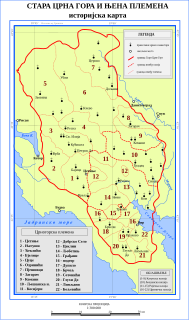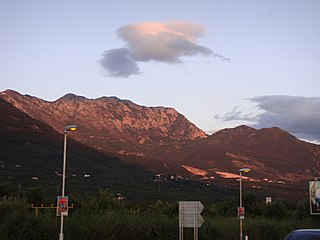 W
WBjelice is a historical region and tribe of the Katunska nahija region of Old Montenegro. The tribe was one of the largest traditional tribes of Old Montenegro and one of nine tribes of the Katunska nahija, along with Cetinje, Njeguši, Ćeklići, Cuce, Ozrinići (Čevo), Pješivci, Zagarač and Komani.
 W
WThe Bratonožići is a historical tribe (pleme) in the Brda region of Montenegro. It appeared during the Ottoman period and was a captaincy of the Principality of Montenegro in the 19th century. Today, it forms part of northeastern Podgorica Municipality. In Montenegro, the majority of people who trace their origin in Bratonožići identify as Christian Orthodox Montenegrins and a part identify as Christian Orthodox Serbs. Brotherhoods (bratstvo) from the historical tribe that settled in Bijelo Polje and became Muslims in the Ottoman period identify as Bosniaks. In the 18th century, many families from the region settled in western Serbia. In Kosovo, a part of the Serbs of western Kosovo come from Bratonožići.
 W
WBythëdosi was a historical Albanian tribe in the Middle Ages. They inhabited the Brda (Montenegro) area in central and eastern Montenegro, north-east of Podgorica
 W
WCeklin is a historical tribe (pleme) and region of Old Montenegro.
 W
WCuce is a clan (pleme) of Old Montenegro, situated in the historical Katun nahiya.
 W
WGojëmadhi was an Albanian tribe (fis) that lived in the Middle Ages. They inhabited the Lješanska nahija region of Old Montenegro, being centered in the area around the village of Goljemadi, west of modern Podgorica.
 W
WGrahovo is a historical Montenegrin clan and settlement in the Nikšić municipality of southwestern Montenegro.
 W
WGrbalj, denotes a historic, rural region, as well as a tribe of the Montenegrin littoral, and a parish located between town of Budva and the Luštica peninsula, Bay of Kotor in coastal Montenegro. Most of the region now lies within Kotor Municipality. It is a fertile region defined by the Lovćen Mountain to the east, and terminating at the low western hills overlooking the Adriatic sea to its west.
 W
WKrivošije are a historical tribe and microregion in southwestern Montenegro, located on a high plateau belonging to the Orjen mountain range, north of the Bay of Kotor. Krivošije was historically located at a tripoint between the Principality of Montenegro, Austro-Hungarian Bay of Kotor and Ottoman Sanjak of Herzegovina.
 W
WKuči is a historical tribe (pleme) and region in central and eastern Montenegro, north-east of Podgorica, extending along the border with Albania. Its historical center is the village of Ubli.
 W
WThe Macure were an Albanian tribe that lived on the territory on the part of Montenegro which is today known as Šekular. Bratonožići and Rovci. Like other non-Slavic tribes of Montenegro, they were either assimilated or expelled. The majority of scholars consider them to have been of Albanian origin. Today, their name is preserved in local Serbian legends and myths, while their name is sometimes used in Montenegro as derogative.
 W
WMalonšići was an Albanian tribe in southern Montenegro. They lived between modern Danilovgrad and Podgorica. By the late 16th century they were slavicized and later assimilated into Bjelopavlići.
 W
WMataguzi was an Albanian tribe in the Middle Ages in southern Montenegro, on the northern shores of Lake Skadar. Their area of settlement included the modern village of Mataguži which takes its name from the tribe.
 W
WThe Mataruge were a medieval Albanian tribe which originally lived in Old Herzegovina and southern Dalmatia. Their name is attested in historical record for the first time in 1222 in the Pelješac peninsula of Dalmatia. Throughout the 20th century, they were considered to have stopped existing as a separate community during the Ottoman conquest of the Balkans in the 15th century. Modern research in the Ottoman archives showed that they had dispersed throughout the western Balkans following Ottoman conquest and formed settlements in other areas. By 1477, a part of them lived in the kaza of Prijepolje, where they formed their own distinct community (nahiye) with 10 villages (katund). One of their leaders appears in the defter to have been a Vojko Arbanash. Other Mataruga communities had moved in central Croatia and Bosnia. Over time they became culturally integrated in the surrounding communities of their new homelands. Families who trace their origin to the tribe are found today in all countries of the western Balkans.
 W
WThe Moračani is one of the Highland tribes and a historical region, Morača (Морача), in central Montenegro. According to folklore, their founder was Bogić Moračanin, hence they also call themselves Bogićevci.
 W
WThe Riđani was a tribe in Old Herzegovina that existed since the late medieval period, first mentioned in 1335, until the mid-18th century. The Krivošije, Grahovo and Rudine brotherhoods claim descent from the Riđani.
 W
WRogami was a historical Albanian tribe in the Middle Ages. They inhabited the Brda (Montenegro) area in central and eastern Montenegro, being centered around the region of Piperi. Toponyms related to them can be found in many parts of the region.
 W
WThe Španji or Shpani were a medieval Albanian clan or fis. They inhabited the region of Nikšić and the valley of the river Zeta in modern-day Montenegro, while also being widespread around Shkodër and Pult. According to folk legends, they were the oldest tribe in the region, while also being in frequent conflict with many other tribes such as the Macure or Bukumiri. They are commonly treated as one of the non-Slavic, "Old Balkanic" people that were assimilated (Slavicized) into the Serb ethnos. Serbianisation of the Španji and other tribes in the region began in the 6th and 7th centuries and according to M. Radovanović (2004) was completed when Serbs from surrounding regions retreated to the mountains of Montenegro and Herzegovina because of the 14th- and 15th century Ottoman invasion. The Špani were quite a rich clan, and its riches,flourished in Albania. In support of this fact we can say that in the cadastre of Shkodra of the year 1416-1417 many Špani (Shpani) are mentioned,being prevalent in the suburbs of Shkodra and owning land and villages, while also reaping privileges from Venetian possessions.